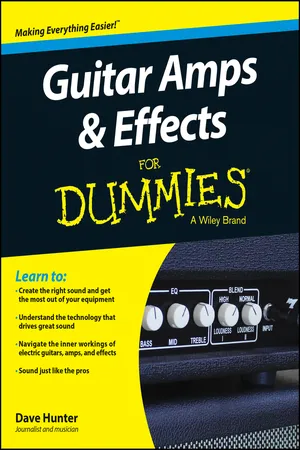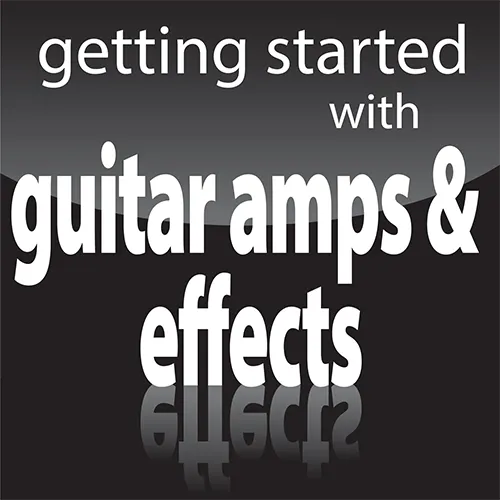Chapter 1
The Concept of Tone for Creative Guitarists
In This Chapter
Exploring the art and science of great tone
Crafting your sound as a creative force
Diving into the workings of guitars, amps, and effects
When guitarists talk about tone, they don’t just mean the balance of bass, midrange, and treble frequencies that an amp’s tone knobs give you access to, or, that is, the general timbre of your sound. They’re referring to the quality of a guitar sound comprised by its depth, richness, texture, and harmonic-overtone content. In short, a player’s tone is the quality and character of his or her instrument’s voice, as projected via any effects and amplifier(s) in use — which themselves are very much a part of electric guitar tone.
Tone is the most-discussed concept in the guitar world today, yet every guitarist out there has a slightly different notion of what great tone really is. And perhaps that’s as it should be: Like anything experienced through your senses, the subject is, to some extent, subjective — we all hear things differently and want to hear different things in our playing. Yet there are also, I firmly believe, some objective standards of quality tone. Although any number of different great tones exist, each should exhibit superb depth, dimension, and harmonic content — its sweetness or richness — even if the end results have very different sonic personalities.
The concept of tone is so fervently discussed because it’s very hard to get a grasp on, and for most guitarists, it is constantly evolving, constantly improving, or is at least part of a never-ending quest for improvement.
This is where Guitar Amps & Effects For Dummies comes in. This book lives to talk tone and to help you narrow down the many great yet extremely different tones that can be achieved with different types of guitars, amplifiers, and effects pedals. You can peruse the rest of this chapter for an overview of what I discuss in detail throughout the rest of this book, or jump in where you see fit for the information deep-dive that gets you into the nitty gritty.
The Sound Chain: Your Sonic Team
When you play an electric guitar, your sound is never just about that guitar; it’s an amalgam of everything else that contributes to the sound. In that sense, although your hands manipulate the guitar itself to make music, that first piece of the chain isn’t really an instrument all on its own. The full instrument includes your amp and any effects pedals or units you use to further manipulate your sound. Each piece of gear you use together to make music, therefore, is part of a sound chain.
The elements in the sound chain aren’t just individual components; they all work together and affect each other’s performance. To understand how any one change in your setup will affect your overall tone, you need to be familiar with each piece of the sound chain, which is one of the major goals of this book. For now, just know that every type of guitar affects the sound of effects pedals differently, and both guitars’ and effects pedals’ tones vary depending on the type of amplifier used.
In other words, this whole sound-chain thing is a game of infinite variables. You’re only going to get a handle on what the end results will be — as opposed to shooting for random sounds every time — by understanding both the individual stages and how they interact with each other.
If you’re fairly new to the concept of working with amps and effects to get the sounds you’re looking for, this all may sound fairly confusing at first, but each section of this book breaks down this reality of the electric guitar into essential and easily digested pieces, so you’ll get the hang of this kind of thinking pretty quickly. Open your mind to the big picture right from the start, and you’ll find it a lot easier to take in the theory of interplay and interactivity between not only guitars, effects, and amps but also between the smaller interdependent components of each of these individual pieces of equipment.
From Classic Tones to Total Originality
Some guitarists — like artists in any field, really — jump right in and find both original sounds and original ways of playing when they are still virtually beginners on the instrument. Many others work their way toward originality by chasing the sounds of notable guitar stars. Some of them never achieve anything you’d call particularly original in their own sound, but that’s absolutely fine too. Whatever works for your own music, and whatever makes you happy with your own playing is absolutely okay, and you can’t let anyone else tell you otherwise.
Whatever types of sounds you ultimately make your own, exploring the sounds of many classic and contemporary artists as well as the gear that helped them achieve them is a great way to expand your own tone palette. When you hear a song you like, give some specific thought to the guitar tone and then see if you can identify what was used to create it. Plenty of the acknowledged classics (along with some fun alternatives) are dissected throughout the course of this book. I also provide a lot of info online to help you get to the bottom of what’s behind different hit-making guitar tones. After you peruse several of these setups, a light bulb often pops on upstairs: “Ah, combing the Fender Telecaster with the Vox AC30 sounds like this, but adding the fuzz pedal and playing it through the Marshall stack sounds like that!” It’s a process of discovery, and the more variety you throw into the mix, the more flexible and creative you’re likely to be in your own tone crafting.
It All Begins with Your Guitar
Whatever kind of sound you’re after, it all starts with your guitar. Make no mistake, an electric guitar can’t make any sound without the rest of your equipment, other than a thin, soft jangle. But when you plug it into an amp (and any effects you use in between), it feeds a signal to the truly electric parts of your rig, and that signal determines the fundamental nature of the sound that comes out the other end, however much it’s shaped along the way.
The signal that your guitar sends farther up the chain is determined by what goes into making that guitar in the first place — as well as, of course, how you play it. But the woods, hardware, electronics, and even the strings you use play an enormous role in shaping the little low-voltage electrical signal that comes out of your guitar and goes into everything else down the line, and the shape of that signal determines the core of your tone.
In addition to what goes into your guitar, its condition, setup, and action (its playing feel, determined by the height of the strings from the frets) have a huge impact on its feel and tone. These details are covered in detail in Chapter 7, where you can explore plenty of DIY care and maintenance issues.
Variations in guitar designs
The sound of any electric guitar is established largely by the fundamentals of its design and construction and the ingredients that go into making it. The following blueprint elements determine the tonal ballpark of the instrument, which is only tweaked or enhanced — but not drastically altered — by whatever else goes into it:
- Body style: Solid, semisolid (that is, semi-acoustic), and entirely hollow electric guitars all have different personalities.
- Scale length: Guitars of different scale lengths (the length of the part of the string that vibrates when you play) have somewhat different characters.
- Neck attachment: Guitars that have necks attached with wood screws sound somewhat different from those with glued-in necks, all else being equal (not better or worse, just different).
In addition to these basics, the woods used to construct a guitar’s body, neck, and fingerboard all play an important part in shaping its sound. A lot of detail is required to cover this topic, and I address it in-depth in Chapter 4, but the density, weight, rigidity, grain, vibrational characteristics, and other factors all play a part.
Pickups and electronics
Your guitar generates the fundamental sonic characteristics of every note you play, but the pickups are the part that makes it electric. Pickups are simple, passive electromagnetic devices, motion sensors essentially (in the early days, many guitar makers even called them mics). They consist of magnets and coils of wire, which produce a low-voltage electrical signal when the movement of a steel string interrupts their magnetic field.
There are many, many different types and makes of pickups out there — the field is huge and really has been booming lately — and different types of pickups offer their own very different sonic personalities on top of the fundamentals generated by the guitar’s body design and woods. A simple change in pickups can make a guitar sound brighter, darker, deeper, bigger, hotter, and all sorts of other things. I cover all the possibilities in detail in Chapter 5, but just keep in mind for now that your electric guitar tone options expand exponentially depending on the pickups you put into it.
Hardware
By hardware I mean the metal components that are attached to your guitar, most of which play some part or other in keeping the strings anchored and keeping them in tune.
Different types of hardware — most notably, guitars’ bridges, tailpieces, and tuners — clearly have an impact on the functionality of the guitar in question: how you tune it up, how you adjust its playing feel, and so forth. Because they are the contact points for the strings, and that’s where your sound originates, these components also greatly a...






